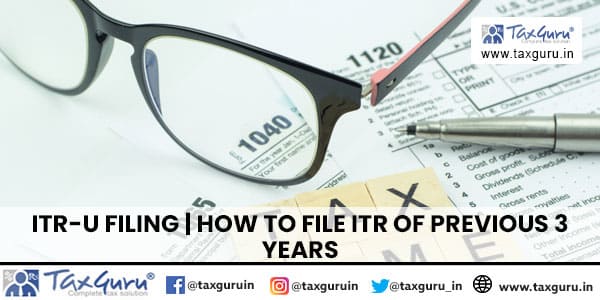How to file updated return (ITR-U)
The updated return, or ITR-U, was put forward in the union budget of 2022 to provide taxpayers with an additional chance to submit if they missed the deadline for filing their tax returns late or to correct any mistakes they made. In order to make the tax filing procedure simpler and more effective for taxpayers, the Income Tax Department of India has implemented several sets of rules and forms. One such form is the ITR-U, or Updated Return, which allows people to make corrections to any mistakes or omissions they made when filing their first forms.
Taxpayers can repair any errors or revisions in their initial return by employing Section 139(8A)’s provisions, while they can do so without worrying about suffering legal repercussions for providing false information.
Who is legitimate to fill out an ITR-U?
- Had previously unfiled return
- Income not properly documented
- Mistaken selection of income heads
- Diminishment of the loss which is carried forward
- Reduction of depreciation not used
- Tax credit reduction under Sections 115JB and 115JC
- Incorrect tax rate
Who is illegitimate to fill out an ITR-U?
- If a modified return has already been submitted
- If the modified return represents a loss,
- If a modified return lowers the amount of income tax owed on an earlier filed return
- If a changed return causes the refund to increase
- If section 132 has been employed to initiate a search
- In the event that the assessee has been updated of any information the Assessing Officer may have concerning the subject under the Prevention of Money Laundering Act, Black Money (Undisclosed Foreign Income and Asset), Imposition of Tax Act, Benami Property Transactions Act, or Smugglers and Foreign Exchange Manipulators Act.
- Lookup or request
- Other notified persons
Procedure to file form ITR-U
According to the Income Tax Department, the updated return has to be filed in two parts.
Part A: Providing Fundamental Details
- Provide the Assessment Year for which you are filing the revised return, your PAN, and your Aadhaar Number.
- Do you have the right to submit an amended return? That is, they are not experiencing situations that hinder them from filing an updated return.
- Rationalisations for updating earnings. This covers causes like inaccurately reported income, incorrectly filed returns in the past, selecting incorrect income headings, etc.
- Are you filing a modified return within 12 months of the relevant AY’s end, or between 12 and 24 months following that?
- Declare if one is filing the revised return in order to receive a tax credit, less carried forward loss, or fewer unabsorbed depreciation.

Part B: Determining the Updated Income and Tax Due
- Head of Income: Additional income returned in compliance with the Updated Return
- Total income as declared on the most relevant valid return (only for instances where the income tax return has previously been filed)
- Total revenue in accordance with Part B-TI
- Any amount that is due, if any (To make a deduction from the amended ITR’s Amount due of Part B-TT.)
- Refundable amount, if any
- The sum due based on the newest and most recent legitimate return (only in applicable instances)
- Refund requested according to the most recent legitimate return, if any
- Complete refund in accordance with the most recent legitimate return, if any, with interest according to Section 244A received
- If relevant, regular assessment tax
- Information on Advance Tax, Self-Assessment Tax, and Regular Assessment Tax payments that weren’t claimed as credits in the preceding return (credit for the same is not to be given again under section 140B(2)
- Relief under section 89, which had not been asked for in the previous return (section 140B(2) forbids relief for the same)
Time limit to file ITR-U
An updated return, or ITR-U, has to be filed within a specific period of time. After the pertinent assessment year concludes, taxpayers have 24 months to file an updated return.
For example:
| Assessment Year | Last Date of Updated ITR Filing |
| AY (2021-22) | 31 March 2024 |
| AY(2022-23) | 31 March 2025 |
| AY(2023-24) | 31 March 2026 |
Penalty for late filing
Penalties are always issued for late filing. If the return is filed within a year of the end of the corresponding assessment year, an extra 25% of the tax liability and interest due on the income left out to be reported must be submitted and paid. If the return is filed within two years of the relevant assessment year and after one year, the penalty gets raised to fifty percent of the amount of the additional tax and interest that is owed.
Verification of ITR-U
ITR-U can be authenticated by –
- In situations involving tax audits, an Electronic Verification Code (EVC) is issued.
- In situations of non-tax audits, the Digital Signature Certificate (DSC).
Benefits of filing ITR-U
- Taxpayers are allowed to file income tax returns for an additional 24 months, even after the original, belated, and revised ITR filing deadlines have dissipated
- In order to lower the probability of upcoming tax letters and legal action, taxpayers can report any undeclared earnings and pay tax on it.
Conclusion: Filing an ITR-U provides taxpayers with an opportunity to rectify mistakes or omissions in their previous tax returns. By following the prescribed procedure and adhering to the time limits, taxpayers can avoid penalties and benefit from extended filing deadlines, ensuring compliance with tax regulations and minimizing legal risks.
*****
The Author is an Income tax, Accounting and GST Practitioner and can be contacted at 9024915488.
Thanks






meaningful information